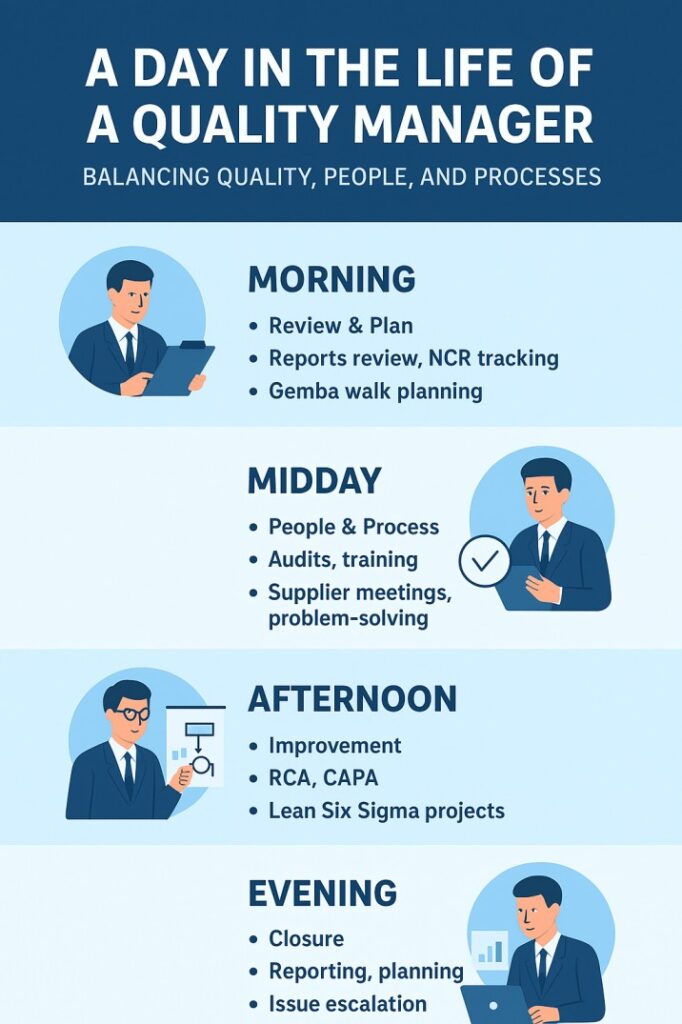Introduction
A Quality Manager’s role is often misunderstood as simply “preparing documents or checking for defects.” In reality, it’s a dynamic position that requires balancing quality assurance, people management, and process optimization. Whether in manufacturing, automotive, healthcare, or services, a Quality Manager is the glue that holds the quality management system (QMS) together.
Every day is a careful mix of strategic planning, hands-on problem-solving, and team collaboration — all while keeping customer requirements and industry standards in mind. Let’s walk through what a typical day looks like for a Quality Manager and why their role is vital to any organization.
Morning – Setting the Quality Agenda
The day usually begins before the production floor gets busy. The Quality Manager starts by reviewing the previous shift’s reports to identify any deviations, non-conformances, or customer complaints.
Typical morning activities include:
- Checking non-conformance reports (NCRs) and tracking corrective action progress.
- Analyzing quality data from SPC (Statistical Process Control) charts.
- Reviewing KPIs such as defect rates, in-house PPM, first-pass right, and customer complaints.
- Planning Gemba walks to observe processes and interact with supervisors and operators.
A short morning meeting with production supervisors and quality engineers sets the tone for the day. This is where priorities are clarified — for example, focusing on a high-priority customer order that needs extra quality checks.
- Preparing daily quality performance reports for management review.
- Following up on unresolved issues with the production, engineering, or supplier teams.
- Planning next-day audits, training sessions, or supplier meetings.
- Reviewing if any escalations need to be communicated to top management.

Mid-day – People & Process Engagement
By mid-day, the Quality Manager is deeply involved in the operational heartbeat of the organization.
Key activities include:
- Conducting Quality Audits – Internal process audits or Layered Process Audits (LPA) to ensure compliance with QMS requirements (ISO 9001, IATF 16949, etc.).
- Problem-solving sessions – Working with cross-functional teams to address supplier issues, in-house defects, or process bottlenecks.
- Training and coaching – Educating staff on quality tools such as 5 Why Analysis, Fishbone Diagram, or PFMEA.
- Supplier interaction – Visiting supplier facilities or reviewing their quality documentation to ensure incoming materials meet specifications.
This part of the day is heavily people-focused. The Quality Manager serves as a bridge between management and the shop floor, ensuring that quality requirements are communicated and understood.
Afternoon – Problem-Solving & Continual Improvement
Afternoons are often when urgent quality issues surface — and the Quality Manager must act quickly.
Common afternoon tasks:
- Root Cause Analysis (RCA): Using structured methods (8D, 5 Whys, Ishikawa) to identify and eliminate the source of defects.
- Implementing Corrective and Preventive Actions (CAPA): Ensuring solutions are effective and sustainable.
- Process improvement projects: Leveraging Lean Six Sigma tools to reduce waste, improve cycle time, and enhance product quality.
- Updating QMS documentation: Revising SOPs, Work Instructions, Check sheets, PFMEA and Control Plans to reflect process changes.
The Quality Manager’s problem-solving role is not only reactive but also proactive — preventing future issues by improving process controls.
End of the Day – Reflection and Planning
The last hour of the day is usually dedicated to closing the loop. This means:
Before leaving, the Quality Manager ensures that critical issues are handed over to the night shift or the next responsible person if required.
Key Challenges Faced by Quality Managers
The role comes with unique challenges, including:
- Balancing speed and quality – Production teams are under pressure to deliver fast, while quality demands thorough checks.
- Managing cross-functional communication – Aligning Production, Maintenance, Engineering, and Supplier on the same quality standards.
- Adapting to changing customer requirements – Especially in industries like automotive, aerospace, and healthcare.
- Compliance pressure – Meeting ever-evolving regulatory and certification requirements.
- Data overload – Managing vast amounts of quality data and turning it into actionable insights.
Why This Role Matters
Quality Managers directly influence:
- Customer satisfaction – Delivering defect-free products builds trust and brand loyalty.
- Operational efficiency – Reducing rework, rejection, and warranty claims saves costs.
- Compliance and reputation – Maintaining ISO 9001, IATF 16949, ISO 14001, ISO 45001, and others.
Without a Quality Manager, organizations risk losing control over their processes, resulting in customer dissatisfaction, increased costs, and reputational damage.
A Quick Glimpse – The Day Summarized
| Time of Day | Key Focus | Activities |
|---|---|---|
| Morning | Review & Plan | Reports review, NCR tracking, Gemba walk planning |
| Midday | People & Process | Audits, training, supplier meetings, problem-solving |
| Afternoon | Improvement | Root cause analysis, CAPA, Lean Six Sigma projects, and documentation updates |
| Evening | Closure | Reporting, next-day planning, and critical issue escalation |
Tips for Aspiring Quality Managers
- Develop strong communication skills – You’ll be talking to operators, managers, top management and customers.
- Learn quality tools & methods – PPAP, SPC, MSA, PFMEA, CP, APQP, 7 QC Tools etc
- Understand industry standards – ISO 9001, IATF 16949, ISO 14001, ISO 45001, MACE VSA or AS9100, depending on your sector.
- Be proactive – Prevent issues rather than just reacting to them.
- Stay adaptable – Quality challenges evolve with technology and market trends.
Conclusion
A day in the life of a Quality Manager is never dull. It’s a role that demands technical expertise, leadership, and empathy in equal measure. The ability to balance quality, people, and processes is what makes a Quality Manager invaluable to any organization.
In this time where customers’ expectations are higher, the Quality Manager is not just a post — they are the driving force for continual improvement and customer trust.

